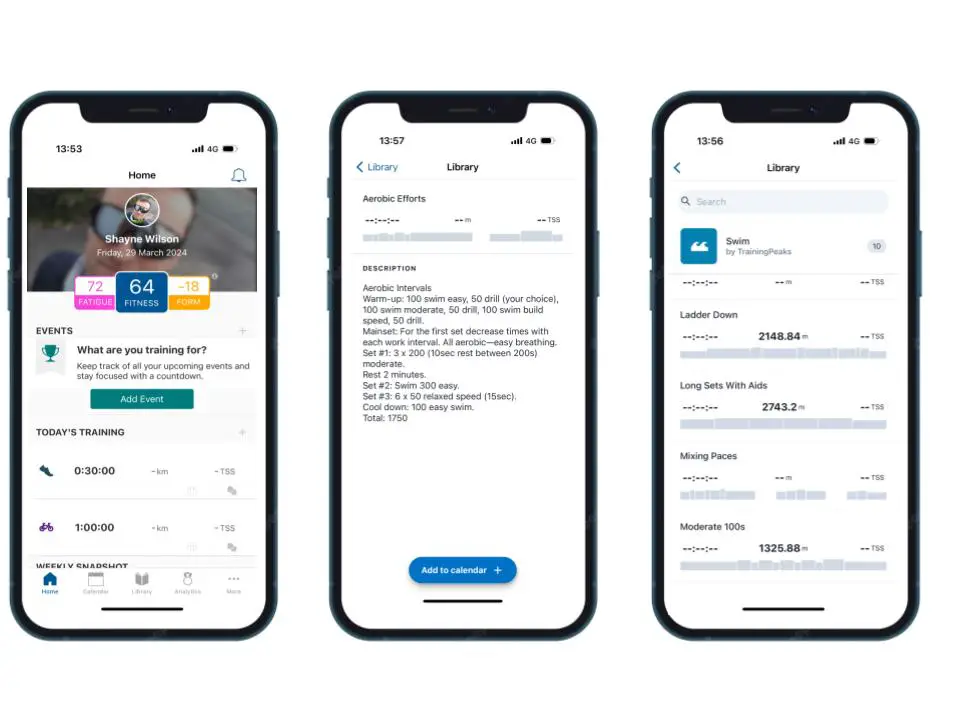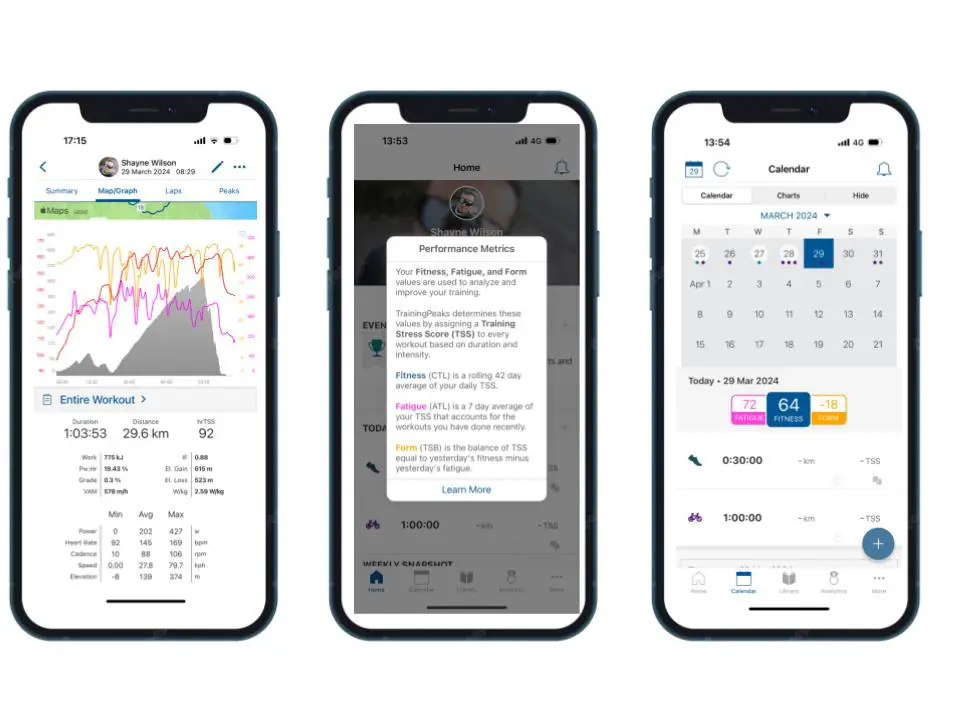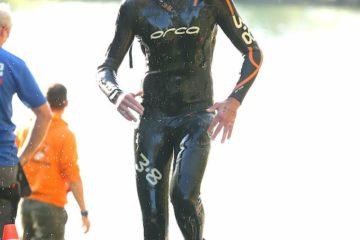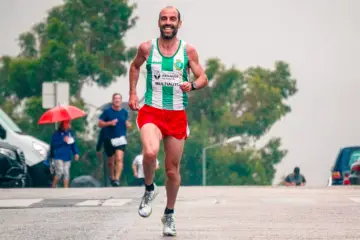TrainingPeaks Review – Is the Premium Subscription Worth it?
Summary of Review of TrainingPeaks
Trivelo Score – 3 / 5
TrainingPeaks has oodles of data, tonnes of it. It will allow to track every nuance of your athletic performance, analyse every second of a workout, and allow your coach to plan very strategically to achieve your athletic goals. What TrainingPeaks isn’t, is a strava like community of athletes. Don’t expect to see “kudos” given for your new PB on here, but you might get a comment from your coach. I can see that Garmin’s new beta platform aligns well to some of the TP data. However, it’s a bit less intuitive and allows for less by the way of planning to season long training cycles.
It is also an aggregator of the plethora of fitness apps there are on the Marketplace. You can sync Zwift, Whoop, Wahoo, Polar, MyfitnessPal, Suunto, Garmin and Apple Watch data to your training peaks account. There are plenty of other apps to integrate with. One I would recommend is HRV4 Training, more on this later, but it is the precursor to Whoop data and adds some science to the question of “I’m ill and should I train today?”. The old adage is that you can’t get fit if you’re not healthy so its important to track both your health markers (Heart rate variability, sleep, stress, diet wtc) and your training markers.

If you’re an athlete syncing this data to their TP – make sure to talk to your coach about it. They should be reviewing this data with you as part of your training regime. You’ll get some great performance data into training peaks about your athletic prowess, but also some great health data via Whoop and/or HRV4 Training. Your sleep, recovery, and diet as
Introduction to TrainingPeaks
Well where to start with reviewing TrainingPeaks. How’s about with a bit of history. Firstly, TrainingPeaks is the brainchild of Joe Friel. A world renowned Endurance coach for USA Triathlon and USA Cycling. The idea spawned out of the need to have an online method of planning, track and analyse the training of athletes. It allows athletes and coaches to interact anywhere in the world using Web, Mobile and Desktop solutions.
Over the years the number of athletes and coaches using the TrainingPeaks Platform has grown exponentially. Meaning TrainingPeaks has a huge amount of data collected on athletes, the effect on performance / fatigue and well being of certain training methods and the outcomes that they have on the body . It’s used this data to create trademarked data points and information about athletes which I’ll go into later on.
Who is TrainingPeaks for?
So who uses TrainingPeaks? Firstly Athletes from a variety of sports (for the purpose of this review Ill be looking at TP from a Triathletes perspective). Such as cycling, triathlon, rowing, running, swimming and so on. As an athlete, you would be using the athletes App. There are two versions of the app, a free version and a premium, paid for version.
Secondly, coaches will use the “coaches app” to monitor the progress of a potentially unlimited number of athletes, build a library of workouts and sets that you can deploy to your athletes and ensure that they’re hitting their goals.
So for the purpose of this review I’ll attempt to review as an Athlete. With the aim of trying to understand the platform well enough to get the best out of you coach:athlete relationship. In doing so potentially benefitting athletes who are self-coached, with the aim of you using the TrainingPeaks app to get the best out of yourself.
Look and feel
The first thing you’ll notice is that it’s plain, simple and easy to digest. You’ll notice your plan, your current “fitness” level (more on this later) and your peak performances. On the mobile app, you’ll see your “fitness” and your plan. Its useful for the page to be simple to make it easier to read, but also so it minimises data transfer when viewing on your mobile.

When you set up with a coach – they should be running through training peaks with you and giving you a tour of what it is, where to find things and what they’ll be monitoring from you.
What Does it Measure?
In short everything. However, its important that you as the athlete understand the detail that is available to you and your coach.
On a Macro level TrainingPeaks tracks 4 things:
Training Stress Score: Each training session is given a score based on its duration and intensity relative to your threshold . The harder the training session, the higher the training stress score it is assigned.
Fatigue: Acute Training Load / ATL is a weighted average of the past 7 days TSS
Fitness: Chronic Training Load / CTL. This is a measure of the amount of training load your body can respond and adapt to. It’s a weighted average of the last 42 days of training. Fitness isn’t a predictor of performance, or how fast you’re going to be. However it is a measure of how much training load you can perform on a daily basis without causing so much fatigue that you’ll need a break from training. Consistency is key, to building this workload amount slowly and progressively.
Massive training days, above your fitness level, need careful build up, recovery and management. That Ironman you want to do is probably 900-1000TSS, would probably need a 3/4 days to recover from, days in which you could have amassed 4 x 80 TSS workouts or more and progressed your fitness further.
Form: Training Stress Balance / TSB. Yesterdays fitness minus yesterdays fatigue gives you your form. +25 is losing fitness, -30 is a fairly extreme amount of training that needs to be adapted to. In general when in deep training for an event you’ll want to keep your form somewhere around -15, but not really below -30 for too long. While tapering for a race you’ll want your form to be between 10 and 20.
TrainingPeaks for Fitness Coaches
As a coach you can use this to plan your training to achieve your goals, as every training session we plan has a TSS, we can carefully manage your training load to ensure that you’re fitness is at its peak, with minimal fatigue and your form on point for your race. With your coach, what are you seeing with regards to progress in Fitness and how is that balanced by your form? These factors take into account your body’s physical response to training, not your daily life stress. Are there things going on in your life that are impacting your recovery from sessions, leaving you tired or getting ill? Recovery is as important as training, you cant get fit without recovering properly and without giving the body the correct training stimulus. The balance between training fitness and your HRV / Whoop recovery data is vital to assess how the body is responding to increased workloads.
Compliance: TrainingPeaks will give you a compliance score of whether you have achieved, under achieved or over achieved a workout based on duration / TSS / both. Im mixed on the need to give this data to an athlete to visualise to them that they “haven’t complied” with a workout, when a sensible decision may have been to cut a workout short, or not do it at all. The negative connotation to not doing a workout is unnecessary and potentially drives bad habits. For example, you make wake up with a cold, not enough to not train, but enough for you to not do 3hrs outside smashing the hill intervals you were prescribed. You might choose to do an hour zone 2 indoors instead, or to not train. Both sensible decisions, and shouldn’t be monitored as a lack of compliance.
Cycling Information through TrainingPeaks
Sounds odd to start with the bike, when triathlon starts with the swim. However, cycling forms the vast majority of any triathlon event and therefore takes up most of your training (or should do). Its where the most of your nutrition will be eaten, sets you up for the run and where you can cover the most distance.
So your coach can pre load workouts into a cycling workout, which will feed into Zwift / your garmin to allow you to train to specific zones you need to develop your fitness. I’ll focus on the headlines you should be looking for as a Triathlete:
Power: Work / Time. How much work can you do over a specified amount of time. Measured in watts and is a great predictor of how “fit” you are as a cyclist. Between blocks your coach should be testing your power via a RAMP test or an FTP test to ensure your training zones are accurate. I would recommend once every 3months. However, power is an output of the body that is affected by many things – illness, fuelling, time of day (some people are better in the morning or later in the day – get used to early mornings Triathlons don’t really start in the evenings!), sleep, stress… the list goes on.
Heart rate: measured in beats per minute. This tells you simply how fast your heart is beating. However, training peaks will give you zones to train in that give a different physiological response to training. Z1 – recovery, Z2 – Aerobic, Z3 – Tempo, Z4 – Threshold, Z5+ – Super threshold / Anerobic / VO2 Max. All triathlons are aerobic in nature, however shorter distances have elements of them that are Anerobic in nature. Also the more competitive you are the more likely you are to have surges in pace that mean to delves in to Anaerobic training. HR is exposed to variables such as fuelling, sleep, stress etc. You will still get the physiological response you need from training in a specific zone, even if your power is slightly off. There is a delicate relationship between HR and power that needs to be discussed between yourself and your coach, in conjunction with you fitness and lifestyle data.
Kcal: Often overlooked by most athletes and coaches I’ve worked with other than to inform which daily calorie intake. However, this is vital information for race day. Ideally on race day you’ll be consuming as many calories as you’re using which takes practice (eating and drinking while training hard / concentrating on coaching points etc.) but also takes training… of your gut. Training your gut to absorb more carbs will dramatically affect your performance on race day, this metric literally tells you how much you need to eat at a specific intensity before you start to delve into your stores. You have about 2000kCal of carbs stored as glycogen, which would last around 2 hrs (if you didnt eat anything) of hard riding. So your training calorie expenditure is useful for your race day nutrition strategy, compared against how many calories you can eat with out creating gastro issues – again challenge your coach for advice on this
Swimming Information in TrainingPeaks
Swimming is a bit of a guess for most training hardware (watches in the main) they assume strokes given certain movements of your arm, when couple with time, they report a cadence (strokes per minute). Is you know the length of the pool, they’ll detect a tumble turn / turnaround to then give you a distance. The user having to remember to lap their timer when they’re taking a recover. All that limits the data that TP can really give. Limited to cadence (of one arm – double it for both), pace, and speed. However, as a coach I think that when you boil swimming down, its about two things:
- Stroke length
- Speed of each stroke
For example if my stroke length is 2m and it takes me 1 second to execute that stroke, then I’ll complete a 25m length in 12.5 strokes and in a time of 12.5seconds.
Similarly, if my stroke has a lot of glide in to make it a 2m long stroke and it takes me 3 seconds per stroke, it will still take me 12.5 strokes, but 12.5x 3= 37.5 seconds for the length. Swimming technique should be to maximise the stroke length to the limits of a persons physical ability (technique, streamlining and making maximal benefit of a persons physical attributes – height, arm length etc) and training to be able to execute that great technique as quickly as possible (through fitness, conditioning and strength). The only platform that comes close is Garmins SWOLF score.
So using TrainingPeaks its useful to see cadence v pace – has your cadence increased while your pace has decreased, or stayed the same – its likely your stroke length has got shorter. Ask your coach how to remedy this, or better still are they spotting this and feeding back to you?
Running Information in TrainingPeaks
So would I use TrainingPeaks – well yes. Im a Level 2 triathlon coach and I’ve used training peaks for nearly 10 years. I understand it, I know how to use it and the benefits it gives me to have an app that aids me to achieve my athletic performance are brilliant. However, if you’re not a data driven athlete, or potentially cant commit to a very structured plan for training then I’d have doubts about using it. The user interface is good, simple but surpassed by other training apps on the market, such as Garmins beta platform.
Conclusion
Throughout writing this review of TrainingPeaks, I’ve found myself swaying from what TrainingPeaks actually is, is it a fitness app, is it a training app, is it an aggregator of all these apps. My conclusion is that TrainingPeaks is a coaching app, used by athletes with enough knowledge to utilise the vast amount of data that TP produces, in order to get the best out of themselves or their athletes.



0 Comments